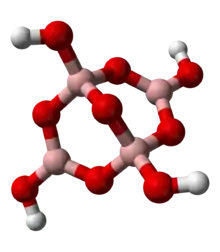
In chemistry, tetraborate or pyroborate is an anion (negative ion) with formula B4O2−7; or a salt containing that anion, such as sodium tetraborate, Na2B4O7. It is one of the boron oxoacids, that is, a borate.
The name is also applied to the hydrated ion [B4O5(OH)4]2− as present in borax
The ion occurs in boric acid solutions at neutral pH, being formed by condensation of orthoborate and tetrahydroxyborate anions:
- 2 B(OH)3 + 2 [B(OH)4]− ⇌ [B4O5(OH)4]−2 + 5 H2O
The tetraborate anion (tetramer) includes two tetrahedral and two trigonal boron atoms symmetrically assembled in a fused bicyclic structure. The two tetrahedral boron atoms are linked together by a common oxygen atom, and each also bears a negative net charge brought by the supplementary OH− groups laterally attached to them. This intricate molecular anion also exhibits three rings: two fused distorted hexagonal (boroxole) rings and one distorted octagonal ring. Each ring is made of a succession of alternate boron and oxygen atoms. Boroxole rings are a very common structural motif in polyborate ions.
The hydrated tetraborate anion occurs in the mineral borax (sodium tetraborate octahydrate) with the formula Na2[B4O5(OH)4]·8H2O. The borax chemical formula is also commonly written in a more compact notation as Na2B4O7·10H2O. Sodium borate can be obtained in high purity and so can be used to make a standard solution in titrimetric analysis.[1]
References